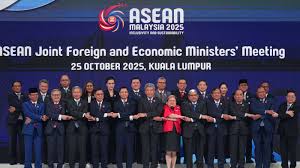Missed opportunity : On India and ASEAN summit in Malaysia.
India could have made better use of the ASEAN Summit.
Since 1995, when India became a dialogue partner of the Association of Southeast Asian Nations (ASEAN), and 2002, when it was upgraded to Summit level, the annual ASEAN summit has been an opportunity for India to reconnect with a region with historical linkages, and now increasing geopolitical importance. In addition to the ASEAN and ASEAN-India summits, the annual East Asia Summit (including the U.S., China, Russia, Australia, New Zealand, Japan, South Korea, India and the ASEAN countries) is a chance for the Indian leadership to interact with the most powerful countries on Indo-Pacific issues. The rebirth of the Australia-India-Japan-U.S. ‘Quad’, for example, took place in 2017, after a decade-long hiatus, on the sidelines of the ASEAN summit. Underlining this importance in his virtual speech at the ASEAN-India summit in Kuala Lumpur on Sunday (October 26, 2025) Prime Minister Narendra Modi called the 21st century “the century of India and ASEAN”, and committed to India’s support to “ASEAN Unity, ASEAN Centrality, and the ASEAN Outlook on the Indo-Pacific”. He also announced that 2026 would be the year of ASEAN-India maritime cooperation, with a focus on humanitarian assistance and disaster response, maritime security and the region’s blue economy. The summit — External Affairs Minister S. Jaishankar represented India — came at a time of increased geopolitical turbulence, including the economic turmoil unleashed by the U.S.’s tariff policy, China’s constraints on crucial exports, and maritime tensions. At the East Asia Summit, Mr. Jaishankar called the times “ complicated ”, taking aim at the U.S. for constraining energy trade with Russia and applying its principles “selectively”, and China for supply chain reliability and market access issues. India and ASEAN also committed to finalising the review of the ASEAN-India Trade in Goods Agreement (AITIGA) soon.
The strong statements and commitment to cooperation did not, however, sufficiently cover for Mr. Modi’s absence from the Summit — he was absent in 2022 also. Malaysian Prime Minister Anwar Ibrahim said Mr. Modi had expressed his inability to attend due to festivities in India, but the explanation was unconvincing as the ASEAN engagement had been planned months in advance. While some pointed to Mr. Modi’s campaign schedule for the Bihar Assembly polls, others cited U.S. President Donald Trump’s presence and India-U.S. trade deal tensions as a possible reason for his staying away. A few even suggested a lingering strain in the India-Malaysia relationship over Malaysia’s diplomatic support to Pakistan during Operation Sindoor, and a visit by the Pakistani Prime Minister to Kuala Lumpur earlier this month. Mr. Modi may have had international, domestic or bilateral reasons, but the no-show was a missed opportunity, especially when other global players including the U.S. and China demonstrated their commitment to regional stability, by simply being there.
